-

人教版高中英语必修2Cultural Relics说课稿2篇
Ⅲ. Analysis of the teaching material:The topic of this unit is cultural relics. Students are quite interested in topics about different cultures around the world. This is the second period of the whole unit. As a reading class, the passage mainly talks about the history of the amber room (how it was made, sent as a gift, lost and rebuilt).According to the new national curriculum, when teaching reading, much emphasis should be put on training the students’ reading skills.Ⅳ. Teaching objectives1. Language objectives:1) Students are required to master the key words and phrases occurred in the passage (e.g. amazing, decorate, belong, in return, less than etc.)2) Students are required to learn the attributive clause and acquire the sentence pattern.2. 1) Students are required to describe a certain thing by using the new sentence patterns.2) Students are required to master two kinds of reading skills—skimming and scanning, and learn to use them in their daily reading.3. 1) Students are required to know the history of the amber room.2) Students are required to appreciate cultural relics and understand the importance of protecting them.Ⅴ. Teaching important and difficult points1) the new words, phrases, and sentence pattern in the course of reading.2) Teaching difficult point: Help the students master two kinds of reading skills—skimmingand scanning and learn to apply them in daily use.Ⅵ. Teaching methods:Task-based method & Top-down model Ⅶ. Teaching aids: PPT, pictures, blackboard Ⅷ. Teaching procedure:

人教版高中英语必修2Wildlife Protection说课稿3篇
When it comes to the students’ studying methods, I'd like to introduce my Ss first. The Ss have a good command of basic language points. They’re interested in learning English, and they take an active part in English class, so they will have fun in autonomous, cooperative and inquiry learning. I will just serve as a guide, showing them the way to explore how to make more progress in their English learning.Now it’s time for the most important stage of this lesson. My teaching procedures are arranged as follows:Step1.Leading-in (3 minute)Play a video of a wide variety of wildlife to introduce my topic. Step2. Speaking (12 minutes)We will use our textbook Page25. Let the Ss fast read the short paragraph to warm up. Ask them to talk about the report on some endangered wildlife in China with the dialogue patterns on the screen. Lastly, I will invite some groups to demonstrate their dialogues about saving wildlife in China.Step3.English play (3 minutes)Watch another video in praise of their excellent performance just now. It’s about Jack Chen’s(成龙)and Yang Ziqiong’s wildlife protection.Step4. Listening (twice 13 minutes)This time, I’ll ask the Ss to fill in the blanks of the monologue of the 2 movie stars above. Step5.Discussion (3 minutes)Which would you like to choose to wear, clothes made of cotton, artificial leather or animal skins? Why ?Step6. Summary (3 minutes)1. If there were no wildlife, there wouldn’t exist human beings. If the buying stops, the killing can, too.2. Animals are our friends. To love animals is to love ourselves. Stop hunting, killing and destroying wildlife.3. Let’s live in harmony with all the living things in the world. Step7. Music appreciation (3 minutes)Let the Ss appreciate the song Earth Song by Michael Jackson. Last but not the least, I will show you my blackboard design.

人教版高中英语必修4A taste of English Humor说课稿3篇
Then I would ask them to think of a funny English or Chinese and tell it to partners. While telling stories, they can use expressions and some acting to help make the story funny. 5 minutes would be given to do this.Those stories they told there will be the material for their writing. Soletting them tell it at first is helpful. And they can make a difference between telling a funny story and writing it down. Generally speaking, it is difficult forstudents to write well because they don’t know what to write and how to write. Asking them to tell their own stories at first can help them come up with what to write.After their telling, I would invite someone to share his/her story with all of us and I would write it down on the blackboard.This example story would be used as a sample to illustrate the format of funny story. Different from a story from teacher or textbook, a story from students can obviously become a interesting material to draw students’ attention.Then I would ask the whole class to put this story into several parts. It might be a little bit difficult for them. So I would ask them to find out whether all the sentences are necessary. After delete some sentences, there are 6 sentences left behind. Then they can easily put them into three parts. After interaction with students, I would teach them the right terms for each part and conclude the format of funny story.This step is the key and difficult point in my lesson. So I mainly usetask-based teaching method in this part and the task for students was divided into several stages. With the separated difficult level, students can find there are usually three parts in writing. They can also learn to write without the unnecessary parts in the process of analyzing. And then I wouldn’t rush to tell them the right terms to them directly. Instead, I would ask them to name them by their own. A confused mind is better for acquiring knowledge.While-writing:Then I would give students 7 minutes to write down this story, without other requirements.With all the preparations in pre-writing, students’ difficulties were cleared. So it would be much easier for them to write down the story within 7 minutes. There are no other requirements because students’ first writing is actually a drafting. It would be revise and edit several times later. Writing, as a skill

人教版高中英语必修3Canada-the true north说课稿4篇
Good afternoon, teachers, It’s my great pleasure to be here sharing my lesson with you.The content of my lesson is Senior English Book 3 Unit 5 Canada —— “The true North”.I’ll be ready to begin this lesson from five parts. Analysis of the teaching material,the teaching methods,the studying methods, the teaching procedure,and Blackboard design.First, let me talk about the teaching material.Part 1 Teaching Material:This unit is about the introduction of Canada. By studying of this unit,we’ll enable the students to learn the geography, population, main cities, and natural beauty, natural resources of Canada. Through the training of the unit, it also requires students to learn some Language skills such as the expressions of position and emotions.So it plays an important part in the English teaching in this book.After studying the teaching material and analyzing the rule of children’s growing of mind,I think the teaching aims are the followings:1.Knowledge objects:(1) make the students learn some new words and phrases(2) make the students understand the content of the lesson.2.Ability objects:(1)To develop the Ss’ abilities of listening, speaking, reading and writing. Especially reading and speaking ability.(2) learn to talk about the characters of Canada in English(3)To train the Ss’ ability of working in pairs.3.Emotion objects:(1)Enable students to understand the characters of Canada..(2)Stimulate Ss to work hard to make China stronger.Part 2 Teaching Methods:I think helping students learn to master new words and phrases and improve the students’ reading and speaking ability is import and the difficult.According to the analysis of the teaching material and the import points and the difficult points,I will use the following teaching methods : question-guiding approach; fast-reading and careful reading; multi-media teaching methods; discussion

人教版高中英语必修4Theme parks说课稿3篇
The oldest and the most popular park in the worldenjoy the exciting activities thereget close to the life-size cartoon characters like Mickey Mouse and Donald Duck Step 3 Pre-reading1.What do you suppose a theme park is ?2.What do you think you can see in a theme park?(1.It is a kind of amusement park which has a certain theme – that the whole park is based on. 2.buildings, castles, statues, rare animals and birds, and so on.) Step 4 Reading ----- Theme Parks –---- Fun and More Than Fun1.Predict : Read the title and the pictures on P. 34 and PredictWhat is the meaning of the title “Theme Park – Fun and more than fun”?(The title means that theme parks are fun to visit, but that they can also be educational and can offer useful information.)2.Skimming Fast read and answer:What activities can we take in a theme park?Amusement park: Bumper car Merry-go-round slide bungee jumping Free-fall rides Horror films Pirate ship Ferris wheel roller coaster3.Scanning Read again and you will find various theme parks are mentioned in the passage . Then what are they ?Theme parks: Sports theme park History theme park Culture theme park Marine or Ocean theme Park Future park Science theme park Disneyland4.Careful reading and find the main idea of each paragraph:THEME PARKS---- entertaining/ educationalPara.1 Traditional parks are places to go for relaxation and to have time away from our busy lives.Para.2 Theme parks are different They’re large and full of things to do, see and buy.Para.3 Theme parks are built around a single idea or theme. One example is a sports park.Para.4 Another kind of theme park is historical more and cultural and can be educational.Para.5 Disneylandwas the first theme park. It is based on the fantasy life and characters of Disney’s films.Para.6 Some examples of educational theme parks include sea world parks and science parks.

人教版高中英语必修3Healthy Eating说课稿4篇
Language learning needs a context, which can help the learners to understand the language and then can product comprehensible output, so computer has the advantages to make the materials attractive.Part 3 Learning MethodsTask-based, self-dependent and cooperative learningPart 4 Teaching ProcedureStep One Lead-in“Interest is the best teacher.” Therefore, at the very beginning of the class, I should spark the students’ mind to focus on the centre topic “the band”. I’ll show some pictures of food to attract their attention and then bring some questions.Question:What kind of food they like?What should go into a good meal?The answers must relate to the diet. After this, the students will be eager to know something about a balance diet and this is the very time to naturally lead the class into Step 2Step 2 Reading for information: skimming and scanning In this step, I use Task-based Language Teaching method, which can give students a clear and specific purpose while skimming and scanning the context.Task 1 General ideaThe students will be asked to just glance at the title and the pictures of the passage, and then guess what they will read in the text. And they’ll be divided into groups of four to have a discussion.The purpose is to inspire the students to read actively, not passively. In addition, the task is to develop the students’ reading skill by making prediction and to encourage the students to express their thoughts in English and cooperate with each other.Task 2 Main idea of each paragraphCooperative learning can raise the students’ interest and create an atmosphere of achievement. Based on this theory, I divide the whole class into 4 groups to skim the whole text and get the main idea of each paragraph.

人教版高中英语必修4Working The Land说课稿3篇
Knowledge objectives:(1) to make Ss grasp the usage of words, expressions and sentence structures: statistics, struggle, thanks to, rid of, some patterns for persuasion, the “ing” form as subject and object;(2)to use learnt knowledge to persuade sb.Ability objectives:(1) to develop Ss’ reading skills(skimming, scanning, word guessing);(2) to improve Ss’ speaking, communicating and cooperating skills.Emotional objectives:to make Ss know the contribution of Yuan,and learn his spirit and his simple life time.Teaching important and difficult points:(1) some words, expressions and sentence structures mentioned above;(2)the content of the text;(3)training their reading and speaking skills.Teaching methods: CLT, TBLT,QT.Learning strategies: CLS, QLS, TBLS.Teaching procedures:Step 1 lead-in: (1) teacher plays a piece of recent news from CCTV about the harvest of the super hybrid rice, and ask students whether they know Yuan or not, and talk about him and his contribution.(2)Brain storm: let Ss describe Yuan in their minds including his appearance, his living condition and so on.Step 2 fast reading tasks:(1)teacher introduces Yuan and super hybrid rice(2)make Ss read the text as fast as possible with questions. Such as: what’s the general ideaof this passage? What’s Yuan’ dream? (skimming and scanning skill)Step 3 intensive reading tasks(1)let Ss read the text silently, find topic sentence of each paragraph and draw the difficult sentences and the knowledge what they don’t understand.(words guessing)(2)teacher and Ss talk about the important words, expressions and sentences together, and ask Ss to retell the content of the text.(summarizing and paraphrasing)(3)teacher summarize this part.(4) read again following the courseware.

人教版高中英语必修5Great scientists说课稿4篇
通过写文章梗概,培养学生综合运用语言的能力,学习用恰当的英语描述科学家的故事。这是本课的教学难点。教师可以使用完形填空的方式来帮助学生整理语篇,从而来降低难度。本课的教学重点的突破方法是:在阅读前,让学生初步了解得出科学观点所需要的基本程序,从而轻松而自然地导入文章的阅读;在阅读过程中,由易到难设计快速阅读和精读的问题,层层推进各种阅读活动,让学生对阅读内容从整体感知到细节理解,最后深层读懂整篇文章,同时加强阅读策略的指导,让每个学生都主动参与课堂教学活动,最终达到提高阅读能力的目的。Step 4 Post-readingGroup Activities四人小组共同合作,在老师的适当指导下,就以下2个问题展开讨论,让学生就所知、所学、所感和所想融入话题,然后抽若干同学代表作小组发言。1. What do you think about John Snow, and what should we learn from him?2. Cholera was 19th century disease, which two diseases are similar to cholera today? Why?

人教版高中英语必修5Life in the Future说课稿5篇
Good afternoon, everyone. It’s my great pleasure to be here sharing my lesson with you. The content of my lesson is Senior English for China Book5 Unit 3 Life in the Future. I’ll be ready to begin this lesson from six parts: Analysis of the teaching material, Analysis of the students, Teaching aims and important and difficult points, Teaching methods and aids, Teaching procedures, and Blackboard design. First, let me talk about the teaching material.Part 1 Analysis of the Teaching Material:This unit is about what human beings’ life will be like in about one thousand years. By studying of this unit, we’ll Enable the students to know the changes in humans’ life and some new inventions bringing about the change and develop the interest in science. This lesson plays an important part in the English teaching in this unit. This is an important lesson in Book Five. From this lesson, it starts asking the Ss to grasp contents of each passage. Therefore, this lesson is in the important position of the teaching material. If the Ss can learn it well, it will be helpful to make the Ss learn the rest of this unit.Part 2 Analysis of the SsAs Senior2 Ss, they are at different levels of English fluency, some of them have lost interest in English. So during the lesson, I arrange a variety of activities to let all of them join in to attract their interest and let them be confident and taste the joy of success.

人教版高中英语必修5Making the news说课稿4篇
今天我们来介绍一下必修五第四单元的授课方式。这个单元的题目是Making the news。应该是学生比较感兴趣的话题,学生往往对新闻工作充满好奇,所以我们可以利用这个机会多设计一些师生互动和学生互动,来激发起学习的积极性,提高学习效率。同时我们可以利用这个单元不仅帮助学生掌握语言知识,培养语言能力,同时让其了解新闻工作的重要性,培养起社会智能感。这个单元分为六个课时,它的教学目标是这样的:语言目标是掌握词汇表中的常用单词和短语,掌握倒装句的一些基本用法。 技能目标是能初步掌握约会的基本句型并在真实的场景下正确运用。新闻报道类文章的写作技能。采访的基本规范和沟通技能。情感目标是对新闻报道的客观性和真实性有更好的理解。对新闻记者的职业有更深入的了解,并能体会其工作的重要性。下面我们来介绍一下第一课时的授课方式,第一课的教学目标是这样的第一课时的教学目标语言目标:单词:Occupation, journalist, editor, photographer, curious, personality, enthusiasm
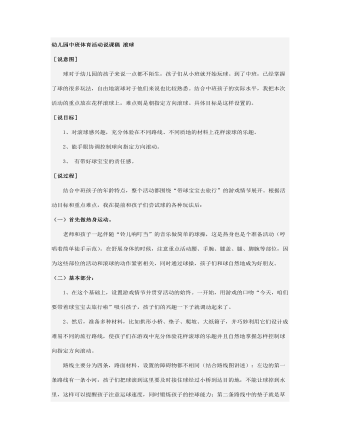
幼儿园中班体育活动说课稿 滚球
1、在这个基础上,设置游戏情节并贯穿活动的始终。一开始,用游戏的口吻“今天,咱们要带着球宝宝去旅行啦”吸引孩子,孩子们的兴趣一下子就调动起来了。 2、然后,准备多种材料,比如拱形小桥、垫子、爬坡、大纸箱子,并巧妙利用它们设计成难易不同的旅行路线,使孩子们在游戏中充分体验花样滚球的乐趣并且自然地掌握怎样控制球向指定方向滚动。 路线主要分为四条,路面材料、设置的障碍物都不相同(结合路线图讲述):左边的第一条路线有一条小河,孩子们把球滚到这里要及时接住球经过小桥到达目的地,不能让球掉到水里,这样可以提醒孩子注意运球速度,同时锻炼孩子的控球能力;第二条路线中的垫子就是草地,孩子们可以体验在垫子上滚球的不同感受;第三条路线是爬坡、第四条中是纸箱组成的山洞……)。
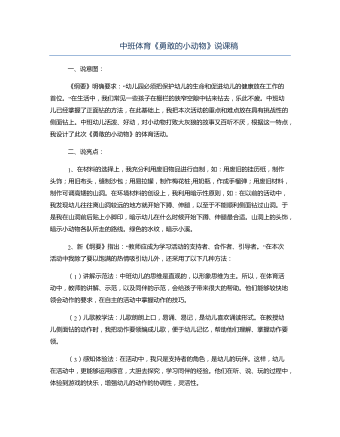
中班体育《勇敢的小动物》说课稿
1、在材料的选择上,我充分利用废旧物品进行自制,如:用废旧的挂历纸,制作头饰;用旧布头,缝制沙包;用易拉罐,制作梅花桩;用奶瓶,作成手榴弹;用废旧材料,制作可调高矮的山洞。在环境材料的创设上,我利用暗示性原则,如:在以前的活动中,我发现幼儿往往离山洞较远的地方就开始下蹲、伸腿,以至于不能顺利侧面钻过山洞。于是我在山洞前后贴上小脚印,暗示幼儿在什么时候开始下蹲、伸腿最合适。山洞上的头饰,暗示小动物各队所走的路线。绿色的水纹,暗示小溪。2、新《纲要》指出:“教师应成为学习活动的支持者、合作者、引导者。”在本次活动中我除了要以饱满的热情吸引幼儿外,还采用了以下几种方法:(1)讲解示范法:中班幼儿的思维是直观的,以形象思维为主。所以,在体育活动中,教师的讲解、示范,以及同伴的示范,会给孩子带来很大的帮助。他们能够较快地领会动作的要求,在自主的活动中掌握动作的技巧。
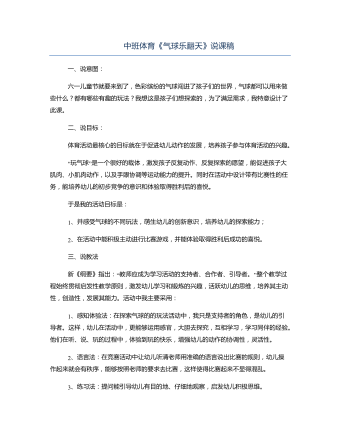
中班体育《气球乐翻天》说课稿
新《纲要》指出:“教师应成为学习活动的支持者、合作者、引导者。”整个教学过程始终贯彻启发性教学原则,激发幼儿学习和锻炼的兴趣,活跃幼儿的思维,培养其主动性,创造性,发展其能力。活动中我主要采用:1、感知体验法:在探索气球的的玩法活动中,我只是支持者的角色,是幼儿的引导者。这样,幼儿在活动中,更能够运用感官,大胆去探究,互相学习,学习同伴的经验。他们在听、说、玩的过程中,体验到玩的快乐,增强幼儿的动作的协调性,灵活性。2、语言法:在竞赛活动中让幼儿听清老师用准确的语言说出比赛的规则,幼儿操作起来就会有秩序,能够按照老师的要求去比赛,这样使得比赛起来不显得混乱。3、练习法:提问能引导幼儿有目的地、仔细地观察,启发幼儿积极思维。
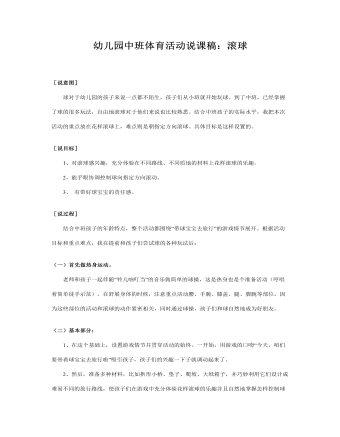
幼儿园中班体育活动说课稿:滚球
[说目标]1、对滚球感兴趣,充分体验在不同路线、不同质地的材料上花样滚球的乐趣。2、能手眼协调控制球向指定方向滚动。3、有带好球宝宝的责任感。[说过程] 结合中班孩子的年龄特点,整个活动都围绕“带球宝宝去旅行”的游戏情节展开。根据活动目标和重点难点,我在提前和孩子们尝试球的各种玩法后:(一)首先做热身运动。 老师和孩子一起伴随“铃儿响叮当”的音乐做简单的球操,这是热身也是个准备活动(哼唱着简单徒手示范)。在舒展身体的时候,注意重点活动腰、手腕、膝盖、腿、脚腕等部位,因为这些部位的活动和滚球的动作紧密相关,同时通过球操,孩子们和球自然地成为好朋友。(二)基本部分:1、在这个基础上,设置游戏情节并贯穿活动的始终。一开始,用游戏的口吻“今天,咱们要带着球宝宝去旅行啦”吸引孩子,孩子们的兴趣一下子就调动起来了。2、然后,准备多种材料,比如拱形小桥、垫子、爬坡、大纸箱子,并巧妙利用它们设计成难易不同的旅行路线,使孩子们在游戏中充分体验花样滚球的乐趣并且自然地掌握怎样控制球向指定方向滚动。
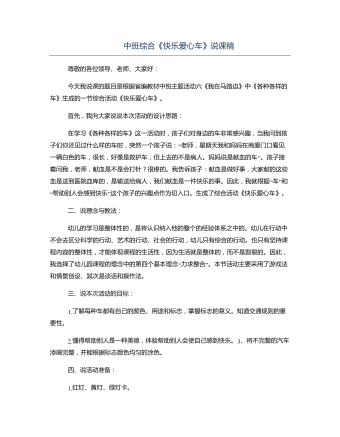
中班综合《快乐爱心车》说课稿
孩子们,转转小脑筋猜个小谜语,孩子们的注意力就集中了起来。我就说出了“车“的谜面:四脚圆滚滚,眼睛亮晶晶,嘀嘀一声叫,招手过路人。我的语气重点在嘀嘀一声叫,孩子马上猜出是汽车。然后就问谁是坐车来的?你坐的车是什么颜色?你做的车大?还是小?引导幼儿懂得车给人们带来了方便,就是车的用途了,幼儿园的车都是黄色的,哪辆车是你坐的?孩子立刻回答自己坐的是1号车或者2号车,这就引出了车是有“标志”的。然后在引导幼儿认识几种常见的特殊车辆,出示110,120,119的车辆,让幼儿分别找出车的标志是什么?它的用途,再让幼儿模仿这几种车跑起来的声音,这时的孩子兴趣很高,都乐意学,嘴里发出(危楼危楼)或者(日日)的声音。
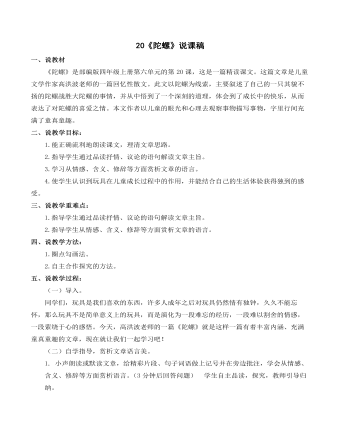
《陀螺》说课稿
在学生声情并茂的朗读后,我追问:同学们,你们猜猜他批注的可能是哪个词?有的学生说“我猜他批注的是高兴,因为我听出了他高兴的语气,并且从他手舞足蹈的动作中我想他一定很高兴所以才会又蹦又跳的。”
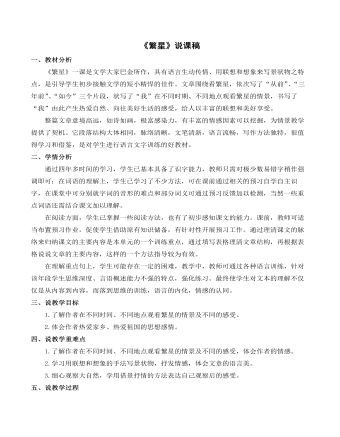
《繁星》说课稿
语文课中“文”的理解往往与“情”交织在一起,所谓“披文入情”,抑或“披情入文”皆言于此。媒体、作者和背景资料的补充,能帮助学生较好理解文本及作者所要表达的情感。上课伊始,充分利用多媒体课件,向学生展示了美丽的星空,把学生带进了一个新奇梦幻的世界。
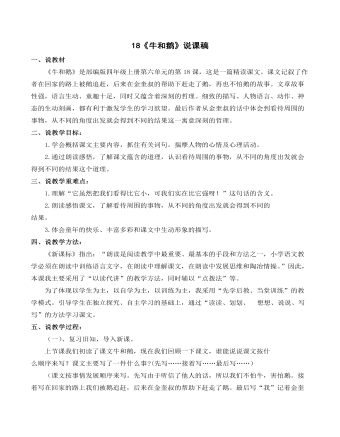
《牛和鹅》说课稿
(我们马上都不说话了,贴着墙壁,悄悄地走过去。我吓得脚也软了,更跑不快。在忙乱中,我的书包掉了,鞋子也弄脱了。)

《灰雀》说课稿
为了这可爱的灰雀,列宁和一位小男孩之间发生了一个怎样有趣的故事呢?让我们带着这个问题赶快走进课文,美美地读一读吧。
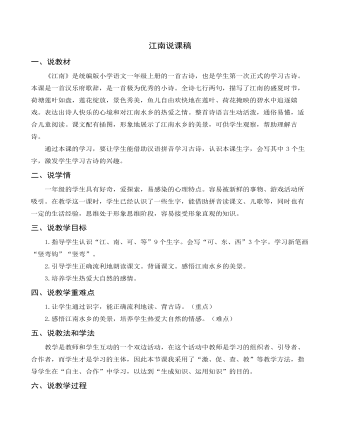
《江南》说课稿
出示贴满荷叶、荷花的小黑板,让学生上台来采摘自己喜欢的荷叶,荷叶背面有本课的生字,该生读对了生字才能摘下荷叶。通过游戏的方式学习生字,增强了趣味性,使学生能积极主动地参与到活动中来,培养学生自主学生的能力。